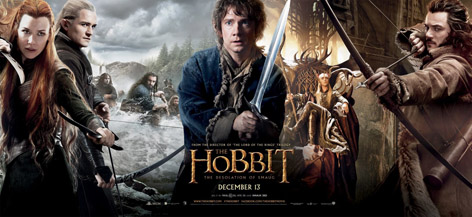|
|
Movie Review - The Hobbit: The Desolation of SmaugBy Matthew HuntleyDecember 19, 2013
Amidst the non-stop fight scenes, chase sequences and character banter, we find ourselves asking, why do we care about any of this? At this point in the saga, we should be much more invested, and the title of the movie suggests that investment should stem from the havoc inflicted by Smaug on the cities of Erebor and Dale. But we’re not, and instead of leaving the movie excited, fearful, or giddy with anticipation for the upcoming conclusion, we’re apathetic. It’s funny, but while watching “Smaug,” I was reminded of the World War II mini-series, Band of Brothers, and its key episode titled, “Why We Fight,” which made it clear why the American soldiers’ mission was essential. I didn’t get that feeling with Bilbo and company. Not that Band of Brothers and The Hobbit are necessarily comparable, but the point is this movie lacks an emotional hook and thus makes it difficult for us to rationalize why this journey is so important. Perhaps too much time was dedicated to the action, style and presentation when the focus should have been the characters and their cause. The story, which has needlessly been spread out over three two-and-a-half-hour-plus movies (Tolkien’s 300-page novel has been overly padded with extraneous characters and subplots), picks up where the first one left off. Bilbo and the 13 elves, led by Thorin (Richard Armitage), are making their way to Lonely Mountain to confront Smaug and take back their homeland. At the same time, they’re being pursued by monstrous, ugly orcs but receive aid from a skin changer named Beorn (Mikael Persbrandt), who sometimes takes the shape of a larger-than-life bear. He provides the group sustenance and horses so they can make their way to the ominous Mirkwood Forest, where they do battle with giant spiders and elves. Lucky for Bilbo, he has his trusted ring, which gives him the power of invisibility, but little does he know about the detrimental effects it’s taking on his self-control.
|

|
|
|

|
Friday, April 19, 2024
© 2024 Box Office Prophets, a division of One Of Us, Inc.


